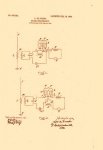- Joined
- Jun 13, 2018
- Messages
- 869
I received a few Private Messages asking for more historical tales of early ham radio-- this one goes back to the very beginning--
.
Lee de Forest was probably the first experimenter to recognize the value of thermionic technology for radio detection. He was first intrigued by seeing the flame of a gas lamp move in sync with the discharges of a spark gap transmitter. Tho he incorrectly concluded that the flame was flickering in response to the signal (it was a air pressure patterns caused by the spark that caused the flickering)-- this observation put him on the right track. His idea went further to investigate the response to electrical vibrations in a gas flame; he even applying for a patent for several radio detection devices based on Bunsen burner flames.
Later, with further experimentation he developed the vacuum tube, with its heated element for thermionic emissions- which became the basis for the modern day vacuum tube. The rest is history.
.
.
I was recently a guest lecturer in a series on the early history of radio- especially on the history of tubes- and at the conclusion I was presented with this "5 Watt Transmitting Valve" (ca. 1918.)
I was told it had come from the collection of a former British radio ham from the 1920's.
It's pretty neat, No ?.... you can plainly see the filament, surrounded by the grid, surrounded by the plate. The filament is still good, after 100 years (and I light it on a very low voltage, just enuff to get a warm glow--it sits on a shelf as a wonderful night light.)
For those that are curious, I encourage reading about de Forrest, and his wonderful discovery.
Lauri
.
.
.
Lee de Forest was probably the first experimenter to recognize the value of thermionic technology for radio detection. He was first intrigued by seeing the flame of a gas lamp move in sync with the discharges of a spark gap transmitter. Tho he incorrectly concluded that the flame was flickering in response to the signal (it was a air pressure patterns caused by the spark that caused the flickering)-- this observation put him on the right track. His idea went further to investigate the response to electrical vibrations in a gas flame; he even applying for a patent for several radio detection devices based on Bunsen burner flames.
Later, with further experimentation he developed the vacuum tube, with its heated element for thermionic emissions- which became the basis for the modern day vacuum tube. The rest is history.
.
.
I was recently a guest lecturer in a series on the early history of radio- especially on the history of tubes- and at the conclusion I was presented with this "5 Watt Transmitting Valve" (ca. 1918.)
I was told it had come from the collection of a former British radio ham from the 1920's.
It's pretty neat, No ?.... you can plainly see the filament, surrounded by the grid, surrounded by the plate. The filament is still good, after 100 years (and I light it on a very low voltage, just enuff to get a warm glow--it sits on a shelf as a wonderful night light.)
For those that are curious, I encourage reading about de Forrest, and his wonderful discovery.
Lauri
.
.
Attachments
Last edited by a moderator:




